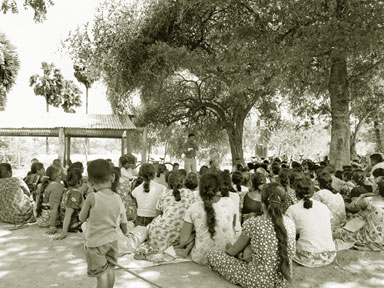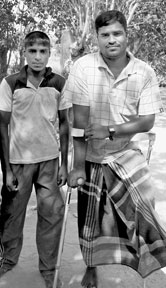|
IDPs getting back on track:
Rebuilding lives
By Dhaneshi YATAWARA
Wasanthamala was waiting for three of her daughters to return from
school in the Kilinochchi town. Her other two girls had stayed home that
day. Wasanthamala and her six children - five daughters and an infant
boy - live in Kilinochchi in their half-built house on a small plot of
land.
 |
|
A village meeting in the Mundimuruppu
GN Division Pix : Dhaneshi Yatawara |
Wasanthamala's life story depicts the shocking reality of a
victimised family of a lost terrorist. Her husband had been a member of
the LTTE and had gone missing at Puthumathalan during the last phase of
the conflict. The family left Kilinochchi in November 2008.
Wasanthamala, with the months-old infant followed her beloved husband
with her girls from Kilinochchi to Murusomotai, then to Dharmapuram to
Vishvamadu, Udayarkattu, Sugandirapuram, Tharavipuram, Iranapallai and
in the last phase to Puthumathalan, where she got injured. During the
last two to three days of the conflict, Wasanthamala, grieving after the
loss of her husband, reached Vattuvakal in Mullaitivu seeking the safety
of the Sri Lanka Army. Then having safely arrived at the Cheddikulam
relief villages, she resettled in her home in Kilinochchi early this
year.
Today, she encounters life with great difficulty, solely depending on
the dry rations she receives every month. "Earlier, before displacement,
I used to work as an accountant in an LTTE fund-raising organisation.
After resettling I couldn't find any job," she said. She and her husband
bought the land where they now live, which is about 40 perches. It has a
well, a budding banana cultivation and a chillie plot. The area was dry
and dusty, but the slightly darkened environment forecast a possible
shower in the evening. Every dark cloud has a silver lining!
Loaded with the responsibility of raising girls in their early teens,
toddlers and an infant boy, Wasanthamala finds it difficult to leave
home for work. She is planning to start backyard poultry as a household
industry. As a 24-year-old girl, Wasanthamala married against her
parents' wishes. Therefore, she cannot seek her parents' help today. Her
parents opposed their marriage as her husband was of an 'unsuitable'
caste. "My husband's family has many girls and they are also not in a
position to assist us," she said with great grief. Tears welled in her
eyes.
Life is not a bed roses for Wasanthamala. However, with funds and a
helping hand from the United Nations Human Settlements Program
(UN-HABITAT) she repaired her house to some extent. A neighbour helped
her build a hen-house for her backyard poultry business. Today, with the
guns going silent and no bomb or mine explosions, this single mother
raises her children in a peaceful environment. Her top priority now is
to find a steady income generating method which she believes she can
find in the near future.
Ajanthan
Wasanthamala is not the only victim of the conflict.
Twenty-four-year-old Annathurai Ajanthan from Paranthan puts a great
effort to rebuild his life, taking care of his mother and sister
Gnaneswari who is still schooling. During the last phase of the conflict
Ajanthan got injured in Puthumathalan. He was given just basic
treatment. His left leg was amputated and he was suffering without
proper medical care. Medical attention was given only to LTTE cadre.
With great difficulty Ajanthan had got crutches from the hospital and on
May 16, 2009 he reached Vadduvakal with his mother and sister, seeking
the protection of the Army. "The Army made announcements for us to reach
their areas and thousands of people escaped," Ajanthan said.
 |
|
Karupaiah Palawan |
"I got proper medical treatment at the Ananda Coomaraswamy relief
village in Cheddikulam, Vavuniya," he said. Ajanthan was lucky. He had
an aunt to take care of him, his mother and sister after the disaster.
Before getting displaced he had owned a small boutique.
LTTE leader Theepan had bought the plot of land next to Ajanthan's
house and built his camp there, in the latter part of 2008, terrorising
the people in the vicinity. "It was the normal practice. They would
forcibly take over someone else's property, set up their camp and the
entire neighbourhood had lived in fear," Ajanthan said, recollecting
memories of the gloomy past. With the sound of gunfire at a distance he,
with his mother and sister, had run to the bunker few feet away. Such
was life for Ajanthan and his family before their displacement.
Today he has started building his house with the support of fellow
villagers and assistance from the UN-HABITAT. As scheduled in the
project, he should build the house with one lockable room and completely
tiled roof in another four months.
Sundaralingum and his wife Subashini lived in the Kandawalai DS
Division, Paranthan with their daughters. This is the second time they
had got displaced with increased LTTE hostilities. In 1996 too they were
displaced and lived away from home for six years.
Their house was on the west side of the A9 highway, over 10 miles
away. During the Eelam War IV, they left their meagre possessions and
ran for safety on November 18, 2008. Amidst the firing and explosions,
they lost their whereabouts. Somehow, they crossed the A9 road and
reached Puliyanpokkanai. After three months, on January 15, 2009, they
reached Mailvaganapuram from where they went to Pudukuduyirippu,
Sugandhirapuram, Kombavil and then to Puthumathalan. To their greatest
relief, they at last heard the Army announcing that they have cleared a
path for the civilians to reach safety. Thus they reached Iranapalai on
April 29, 2009. Then they settled down in the Ramanadan relief village.
Sundaralingum earns his living as a labourer settling back in their
original plot of land, life has become a hard task. They have started
building their house after resettling on March 3.
Kanthimadi (68) of Mundimuruppu village, was more than happy to
return home. She was eagerly listening to the details provided at the
village meeting held in the kovil premises on funds they are entitled to
receive to rebuild their houses.
Starting from Thunukkai, Kanthimadi moved to 21 places with her
children and grandchildren until they reached Puthumathalan. "We hardly
had time to figure out the directions. We ran to whichever the direction
from which there was no firing," she said disclosing her unpleasant
experience.
 |
 |
| Subashini with her daughter |
Ajanthan (on right) |
Today she lives alone in her crooked house. Relatives still live
around the place, to her comfort. "All my 11 children are married and
live with their families. I can't ask them to leave their families to
come and look after me. How can I ask them for help when they are also
struggling", she questioned.
Karupaiah Palawan was also at the meeting. He spoke Sinhala fluently.
"I'm from Ratnapura. As a 26-year-old man, I came to this village in
1976 with my uncles to cultivate paddy fields," said the old man with
much happiness. "My mother is Sinhala," he said. "I lost my eldest son
in 1999 - he was 19. He was wounded in an LTTE artillery attack and the
LTTE refused to treat him though we took him to the nearest hospital. I
was helpless at that point and I could not do anything. The LTTE did not
even try to treat my son," Palawan said. Three days later his son's leg
was amputated, but on the same day he died.
"When we were escaping the LTTE, we ran for miles and I carried one
of my old aunts. We did not rest for one night until we were far away
from the sounds of gunfire," he said. At Sungandirapuram, Palawan and
his family along with other groups managed to escape the LTTE grip and
reach Sri Lanka Army personnel. "The LTTE was blocking us from all
sides. They questioned where we are heading at every point. Misleading
them many times and risking our lives, we reached the safety of the
Army," he said.
"Now I have started cultivating two acres of paddy land and I'm a
tenant farmer as well," he said explaining his efforts to rebuild his
life. "I never thought we will return home alive. The Army saved us from
misery and thanks to them we live in peace today," Palawan said with
great gratitude.
Families selected
The Mundimuruppu Grama Niladhari Division has six villages. According
to Grama Niladhari Aiyathurai Thruwarudchelvan, 112 families have been
selected from the GN division for UN-HABITAT assistance. During these
meetings the villagers are educated on the process and documentation
they need to produce. The project is fully funded by the Australian
Government. The UN-HABITAT gives each selected family Rs. 325,000 to
reconstruct or rebuild their houses. To lay the foundation Rs. 75,000 is
given and with close monitoring Rs. 100,000 is given at the second stage
to raise the walls. The next instalment would be Rs. 117,500 to build
the roof. The last instalment would be Rs. 32,500.
Health concerns
The villagers are not supposed to use asbestos or tin sheets for the
roof, taking the health impact into consideration. They should use roof
tiles. The Divisional Secretary facilitates the villagers by permitting
sand, cement and timber transportation without delay. Special
consideration is given to these people as resettling them is a top
priority for the Government. The villagers get-together and buy the
items collectively from selected places at reasonable prices. With all
this support, a family is generally capable of building the house with a
completed roof and one lockable room. With time and as they start
earning money, the family has to complete their house.
Using an owner-driven approach, the program helps families to
actively take charge of their own recovery. They plan, implement and
monitor their own progress. Their early involvement ensures that the end
result is a home that reflects their own aspirations. The process also
rekindles the local economy. Material and labour are procured locally.
This ensures that funds remain within the communities, while the
families earn or save by contributing their labour.
 |
|
A house nearing
completion |
According to UN statistics, by August over 1,000 families have
started rebuilding their homes in the DS divisions of Kandawalai,
Karanchchi, Poonakary, Manthai East, Oddusudan, Thunukkai and Vavuniya
North. Another 170 families have completed repairs and many others are
nearing completion. The UN-HABITAT staff works closely with the
Government line ministries, both in Colombo and at provincial level. The
selection criteria solely depends on the approval of Government
officials.
The war paid the price for peace. The past is history and the future
is a mystery. This moment is the gift which can create wonders. With the
International Day for Peace around the corner, to be specific on
September 21, it is the correct time to give serious thought to
sustaining peace. A permanent home is the most valuable asset for a
family in a financial sense and is a sign of social dignity. It makes a
person feel safe in his/her surroundings.
Housing alone would not do however. Effective coordination is
essential to ensure that resources are not mis-allocated, creating
oversupply in some areas and under supply in others. Equally important
are the issues of quality standards and linkage between housing and
other infrastructure agencies, including water and sanitation,
electricity, roads and other social services. Stability of a community
is the key to maintain peace in a country.
People should realise that everyone belongs to each other. Once
Mother Teresa said, "If we have no peace, it is because we have
forgotten that we belong to each other".
|

